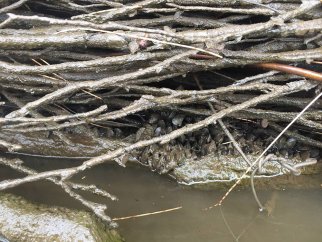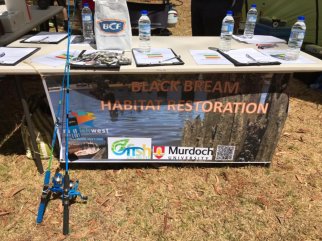At south coast estuaries and rivers, you’ll often find Western Angler editor Scott Coghlan with his light tackle set-up working lures and soft plastics for black bream. In this week’s edition of Scott’s Species, the bream enthusiast discusses one of his favourite fish to target — black bream. Continue reading “Scott’s Species – black bream, an estuarine and river favourite”
Tag: Black bream
Filling the Peel-Harvey Estuary to the bream with the important fish species
Imagine helping boost the stocks of an iconic fish species in one of our very important estuaries while still at school?
Well, students at one Mandurah secondary college are doing exactly that as part of an initiative supported by Recfishwest.
John Tonkin College (JTC) students are spending their time in the classroom, and also out of it, working to ensure black bream stocks in the Peel-Harvey Estuary remain abundant for many years to come.
WATCH: Check out this great little video about the initiative – The Black Bream Project!
Led by the Peel-Harvey Catchment Council alongside Murdoch University and JTC, Recfishwest CEO Dr Andrew Rowland said the program was working to increase stewardship of our estuaries and teach kids that healthy rivers lead to healthy bream stocks.
“Wild black bream were caught from the Murray River, which is part of the Peel-Harvey catchment, to be used as broodstock as part of the project,” he said.
“The fish are spawned in tanks at Murdoch University, then are grown out to 3cm juveniles by the students at John Tonkin College before being released.
“This gives the students the opportunity to become ‘aquaculturists’, helping maintain the tanks, feed and grow the black bream before the fish are released into the Murray River – how good is that!?”
WATCH: Check out this quick video of JTC students releasing baby black bream into the Murray River
In the video, Peel-Harvey Catchment Council Science Adviser Dr Steve Fisher said:

“It’s really important scientifically that we really try and bolster the stock of the bream through doing this stock enhancement,” he said.
“But the major part of the project is getting that community engagement and buy-in, bringing the community along for the ride, so they can understand how important it is to maintain the river in a good state for fish.”
Hands-on learning to protect black bream
As the video shows, the project has given John Tonkin College students a hands-on learning opportunity in a field which is going to have increasing importance in securing abundant fish stocks and the great fishing experiences they provide in the future.
Dr Rowland said the popular course was helping students develop a close connection to the Peel-Harvey Estuary and its black bream, while harnessing more of an understanding of our important estuary systems.
“I wish there was a program like this when I was at school and, who knows, while this program is nurturing black bream stocks, maybe it is also nurturing WA’s future fisheries scientist, researchers and fishers,” he said.
Great community project see black bream released into the Murray River
There is something great about seeing popular fishing species being stocked into popular fishing spots. Continue reading “Great community project see black bream released into the Murray River”
Giving bream fishing in the Swan more mussel
A new trial project by Murdoch University will be providing valuable evidence to support future habitat enhancement and restoration projects in our estuaries.
The project is to encourage the growth of black bream’s favourite food the black pygmy mussel.

We support projects such as this as fishing experiences rely on plentiful fish stocks which in turn require healthy and productive aquatic ecosystems. This is especially true in estuarine environments, which act as important nursery habitats for many key recreational fish species.
In the case of the black pygmy mussel, not only do they filter the water preventing algal blooms and fish kills, but the mussels are also an important food for black bream. More mussels mean more food for bream, thereby improving the bream’s growth rate and body condition. This means bigger and better bream which in turn will mean better fishing experiences.
Newly hatched black pygmy mussels are called spat and these spat like to settle on logs, branches, pylons, rocks and any other submerged habitat. Unfortunately, filamentous algal also like to settle on this structure and once the algae have settled there is no room for the mussels to settle and grow.
This project has two main parts.
Part one – Snag for a Snag
Part one of the project involves volunteers brushing algae off snags in the upper Swan River when the mussels are spawning creating an abundance of habitat for mussel spat to settle on. Strong colonisation of these snags by mussels will then preclude future growth of algae and provide an ongoing food source for black bream in the Swan River.
To date there have been three volunteers cleaning days to make habitat available for mussel spat. Check out the video of these cleaning days below.
https://www.facebook.com/alan.cottingham.96/videos/689862281837445/
Part two – Swan River’s first mussel reef trial
The second part of this project involves the deployment of a mussel reef, the first of its kind in the Swan River estuary system. Not only will this reef increase diversity of habitat around the flats in the estuary basin it will also improve the general health of the Swan River. Mussels, filter-feeders by nature, are already attached to these deployed reefs and will immediately begin to consume plankton and non-living material from the water column, in turn improving light penetration and growing conditions for aquatic vegetation plants.
Check out the video of this reef below
‘’Mussels can positively affect an ecosystem by its capacity to filter water and greatly improve the health of the water system in which they inhabitant,’’ Project coordinator Alan Cottingham says.
You can see the difference they make in a tank full of water here.
Having healthy fish habitats is key to having healthy and sustainable recreational fisheries and Recfishwest is proud to support programs and initiatives that help keep our environment healthy.




This project was funded by the Recreational Fishing Initiatives Fund and is a great initiative in providing better habitat which supports better fishing.
You can read more about this exciting project by visiting the RFIF page – Swan River Habitat Restoration.



Swan River’s First Mussel Reef Trial
Great fishing experiences rely on plentiful fish stocks and healthy and productive aquatic ecosystems. This is especially true in estuarine environments, which act as nursery habitat for many key fishing species as well as a lifetime habitat for others.
Murdoch University have been working on a project to improve the recreational fishing experience in the Swan River Estuary by providing and restoring complex habitat and prey communities with funding from the Recreational Fishing Initiatives Fund.
The health and habitat of the Swan River Estuary System is extremely important for its inhabitants and the community who access it. A habitat that provides shelter for fish, as well as acting as an attractant for prey communities is what sets the scene for a healthy and self-reliant eco system. In turn, it can improve the overall health of the system which will in turn, improving recreational fishing experiences.
Part three (final stage):
VOLUNTEERS and FAMILIES NEEDED to help restore the Swan rivers mussel populations.

Did someone say free sausage sizzle? Yep! Come down this Saturday, to help Murdoch University researchers with a project to restore habitat and help bring back an abundance of black bream to the Swan River, as part of a project titled ‘Snag for a Snag.’ It’s a great day to come down and enjoy the beautiful swan river, lend a hand and even have a fish afterwards! Volunteers will help by preparing the banks of the river for the arrival of the Black Pygmy Mussel spat.
The newly hatched black pygmy mussels, called spat, attach themselves to the clean snags, increasing important prey communities for black bream, thereby improving the breams growth rate, body condition and therefore enhancing the recreational fishing experience.
WHEN: 10am Saturday 16th November
WHERE: Kings meadow Oval Guildford
WHAT TO BRING: sturdy footwear, boardshorts/bathers, waders.
Water, snacks and a BBQ will be provided.
Part two:
The second part of this project commenced on March 22nd with the deployment of a mussel reef, the first of its kind in the Swan River Estuary System. Not only will this reef increase the diversity of habitat around the flats in the estuary basin, thereby attracting fish through provision of greater food abundance and diversity as well as shelter, it will also improve the general health of the Swan River in that particular location. The mussels, filter feeders by nature, are already attached to these reefs and will immediately begin to consume plankton and non-living material from the water column, in turn improving light penetration and growing conditions for aquatic vegetation plants.
‘’Mussels can positively affect an ecosystem by its capacity to filter water and greatly improve the health of the water system in which they inhabitant.’’ Project coordinator Alan Cottingham says.
You can see the difference they make in a tank full of water here.
Local volunteers have been enthusiastically putting their hand up to engage in the project, assisting in the restoration and deployment components whilst raising awareness of the importance of environment quality for fish stocks. Check out the reef’s deployment video below all made possible with help from volunteers from the Marine Men’s Shed, Murdoch University Dive Club, Murdoch University students and other local volunteers. Reef locations are yet to be announced.
This trial project will explore the potential for scaling-up of such projects, providing valuable evidence to support future habitat enhancement and restoration projects in other estuaries.
You can read more about this exciting project by visiting the RFIF page – Swan River Habitat Restoration.


Part one:
Earlier in the year, Murdoch began part one of the project by cleaning and re-snagging existing habitat in the upper Swan River to align with the expected mussel spawning cycle. The newly hatched black pygmy mussels, called spat, attach themselves to the clean snags, increasing important prey communities for black bream, thereby improving the breams growth rate, body condition and therefore enhancing the recreational fishing experience. A short video of this project can be viewed below.
